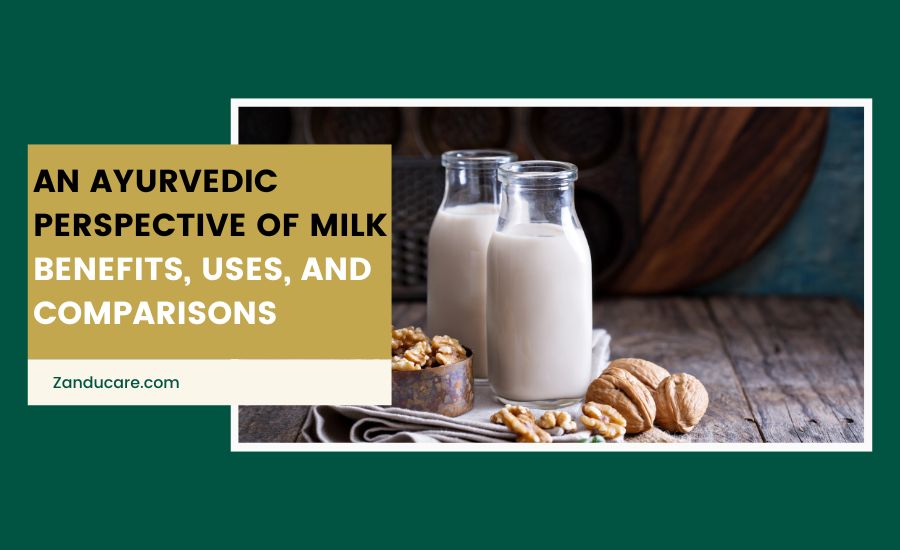The ancient Indian medical system known as Ayurveda values milk for its therapeutic and nutritious qualities. A complete diet fosters general health and balances the doshas (body energies). Beyond being a basic food item, milk plays a significant role in daily life, holidays, and rituals in Indian culture. Its use in various foods, drinks, and traditional medicines shows its versatility.
This post aims to provide a comprehensive Ayurvedic understanding of milk, including its advantages, moderation, and function in preserving the body's equilibrium. By reading this post, readers will better grasp how to include milk in their meals in a way that is both effective and compliant with Ayurvedic principles.
The Ayurvedic View of Milk

Milk is a crucial and sacred food in Ayurveda, valued for its nourishing and calming properties. It is regarded as a complete diet that promotes general health and aids in balancing the doshas (body energy). Traditionally, milk has played a significant role in Ayurvedic daily routines and practices, and it is used in various therapeutic formulations and nutritional advice.
Milk is also important in spiritual activities, where offerings and ceremonies frequently involve it. Ayurveda places a high importance on milk because it helps with digestion, builds strength, and provides vital nutrients. As a result, milk plays a significant role in ancient Indian medicine and culture.
Properties of Milk According to Ayurveda
Rasa (taste): In Ayurveda, milk has a sweet taste. This sweetness is soothing and nourishing, making milk ideal for calming the mind and body. The sweet taste of milk helps to increase Ojas, the vital essence that supports overall health and immunity.
Virya (potency): Milk has a cooling potency. This means it helps to calm and balance the Pitta dosha, which is associated with heat and inflammation in the body. The cooling nature of milk makes it beneficial for conditions related to excess heat and acidity.
Vipaka (post-digestive effect): Milk's post-digestive effect is also sweet. This means that milk continues to have a nourishing and soothing impact on the body after digestion. The sweet Vipaka supports good digestion and helps build tissues and maintain strength.
Prabhava (special effect): In Ayurveda, milk is special because it can promote Ojas and support overall vitality. It is particularly known for its calming and grounding properties, which make it beneficial for those who need to reduce stress and anxiety. Milk's unique combination of taste, potency, and post-digestive effect helps to enhance its special effects on the body and mind.
Milk nutrition facts
The USDA has provided the following nutritional data for one cup (8 ounces) of reduced fat (2%) milk.
Calories: 122
Fat: 4.6g
Sodium: 95mg
Carbohydrates: 12g
Fibre: 0g
Sugars: 12g
Protein: 8g
Calcium: 307mg
Health benefits of milk

Improves bone density
Calcium and vitamin D from milk and other dairy products are essential for strong and healthy bones, but they may also help prevent osteoporosis, a disorder that weakens bones and raises the risk of fractures. There is a link between consuming dairy products in childhood and adolescence and a lower risk of osteoporosis later in life.
It may protect against cancer
There has been conflicting research on the potential protective effects of calcium against ovarian, breast, and colorectal cancers. Overall, though, it appears possible that dairy products and supplements containing calcium could provide some defence against these tumours.
Aids your digestive health
Concentrating on digestive health can help you get the most out of your food. To start, get three servings of milk every day. Probiotics found in dairy products include vitamin D, which helps absorb calcium; B vitamins, which aid in converting food into energy; and selenium, which stabilizes metabolism.
Strengthens your heart health
Dairy milk can keep your heart healthy. Numerous studies have associated including low-fat or fat-free milk in your diet with a lower risk of adult cardiovascular disease, type 2 diabetes, and blood pressure.
Types of Milk and their Ayurvedic benefits
Below is the list of types of milk and its Ayurvedic benefits:
Cow’s milk
Cow's milk is thick, laxative, cold, and prone to mucous formation. It tastes sweet (rasa), cools the stomach (Virya), and has a long-term sweetening effect (Vipaka). Cow's milk is highly respected in Ayurveda for relaxing pitta and vata, provided it is warmed up and spiced suitably. Its cool weight might exacerbate kapha, which is already cool.
Buffalo’s milk
The sages recommended buffalo milk because it has soothing qualities. "Being thicker and colder than cow's milk elevates Kapha and calms Pitta and Vata. Moreover, it hinders rapid removal.
Goat’s milk
Goat's milk makes the spicy, cooling, sweet rasa, Virya, and Vipaka. It is nourishing and fortifying, similar to cow dairy, but it tends to be lighter and less mucus-forming. Goat milk is tridoshic, balancing for all three doshas, and preferred milk for Kapha when consumed in moderation. The minor astringency of goat milk may irritate vata in certain people.
Plant-based Milk alternatives
Plant-based milk alternatives like almond milk, soy milk, and coconut milk are popular choices for those avoiding dairy or following vegan diets.
- Almond milk is made from ground almonds and water, offering a nutty flavor and creamy texture. It's rich in vitamins and minerals, particularly vitamin E.
- Soy milk, derived from soybeans and water, provides a creamy texture and is high in protein, making it a popular dairy substitute.
- Coconut milk, made from grated coconut flesh and water, has a rich taste and is often used in cooking and baking. It contains healthy fats and adds a distinctive flavor to dishes.
These alternatives offer diverse nutritional profiles and flavours, catering to various dietary preferences and needs.
How to consume Milk according to Ayurveda?

One should avoid consuming cold milk from the refrigerator to ensure optimal digestion. Heat the milk until it boils. After letting the milk foam, reduce the heat and boil for five to ten minutes. Heating the milk causes a change in its molecular structure that makes it much easier to consume for humans and lowers its KAPHA content, which makes it easier to digest.
On top of that, you won't be surprised to learn that Ayurveda prohibits milkshake intake. According to Ayurvedic guidelines, mangoes, melons, and other sour fruits should never be blended with milk or yoghurt.
When combined with milk, bananas can reduce gastric fire (agni) and alter the flora of the intestines, producing toxins that can lead to sinus congestion, colds, coughs, allergies, rashes, and hives.
What is the right time to consume milk as per Ayurveda?
Milk is an essential component of the Indian diet and is frequently called the "complete food." It's frequently consumed as a beverage and added to various curries and sweets. Protein, magnesium, potassium, and vitamins A, B1, B2, C, and D are all abundant in milk.
It is even considered a complete food because of its abundance of minerals, vitamins, fat, protein, and carbohydrates. Ayurveda places great emphasis on milk because of its nutritional and digestive qualities. If you enjoy drinking milk as much as I do, keep reading to learn when and how to do it, according to Ayurveda.
Also, do check our related guides:
Comparisons: Ayurvedic perspectives on different types of Milk
|
Type of milk |
Ayurvedic prespective |
|
Cow’s milk |
Considered nourishing, balancing Vata and Pitta doshas. Best consumed warm with spices for digestive benefits and calming effects. Promotes Ojas (vitality) and overall strength. |
|
Goat’s milk |
Lighter than cow’s milk, suitable for Kapha types in moderation. It can be warming and easier to digest. May aggravate Pitta if consumed excessively. |
|
Buffalo’s milk |
Heavy and cooling, it is beneficial for Pitta in moderation. It provides strength and nourishment, but excessive consumption can increase Kapha dosha. |
|
Almond milk |
Cooling and lighter, suitable for Pitta and Kapha in moderation. Rich in vitamin E and minerals. Can be fortified with nutrients. |
|
Soy milk |
It is cooling and high in protein, suitable for Pitta and Kapha types. However, if not properly warmed, it may aggravate Vata. |
|
Coconut milk |
Cooling and nourishing, it is suitable for Pitta and Vata in moderation. High in healthy fats, it supports digestion. Due to its richness, it is best used sparingly. |
Conclusion
Ayurveda emphasises milk because of its nourishing qualities and ability to balance the doshas. Its pleasant flavour aids in digestion and enhances general well-being. Ayurvedic writings highlight its capacity to strengthen the body, elevate Ojas, and soothe the mind. When incorporating Ayurvedic principles into daily life, the health advantages can be maximized, regardless of whether milk is drunk as cow's milk or through plant-based alternatives like almond, soy, or coconut milk.
Knowing the importance of milk in Ayurveda, its flavour, strength, and impact on doshas helps us make wise decisions about how we drink it. Milk can be consumed in ways that fit individual constitutions and preferences, whether for its cooling influence on Pitta, grounding properties for Vata, or moderation for Kapha. These ideas promote a harmonic, balanced lifestyle that aligns with natural health concepts while respecting traditional wisdom.
FAQs
1. What are the benefits of drinking milk, according to Ayurveda?
Ayurveda considers milk nourishing and calming. It promotes strength, digestion, and Ojas (vitality). It balances doshas, supports bone health, and enhances overall immunity.
2. Which type of milk is best for my dosha?
Warm cow's milk flavoured with spices is the best for Vata. Cool cow's milk with additional cooling herbs is beneficial for Pitta. Low-fat milk for the kapha should be used in moderation, perhaps with warming spices.
3. Can I drink milk if I am lactose intolerant?
Lactose-intolerant individuals can try lactose-free cow’s milk or plant-based alternatives like almond or soy milk, ensuring they suit their digestion.
4. What are the best times to drink milk as per Ayurveda?
According to Ayurveda, milk should be consumed warmly in the morning or evening to facilitate digestion and encourage calmness before bed.
5. Are there any Ayurvedic recipes using milk for better health?
Recipes include turmeric milk (haldi doodh) for immunity, almond milk for strength, and milk with spices like cardamom or ginger for digestion.
6. Can plant-based milk alternatives be used in Ayurveda?
Yes, plant-based milks such as soy, almond, or coconut milk are recognized as substitutes in Ayurveda. They can be selected according to dietary requirements and dosha balance.
7. What combinations of milk and foods should be avoided?
Ayurveda advises against combining milk with sour fruits, fish, meat, or salty foods, as they disturb digestion and dosha balance.
8. How does the Ayurvedic view of milk differ from the modern perspective?
In Ayurveda, milk is viewed as a complete food with unique doshic advantages, although contemporary viewpoints place greater emphasis on nutritional value and allergies or intolerances.
Reference
- Calcium and vitamin D from milk and other dairy products are essential for strong and healthy bones(https://onlinelibrary.wiley.com)
- Cow’s milk - Considered nourishing, balancing Vata and Pitta doshas(https://www.ayurpub.com)
- Almond milk - Rich in vitamin E and minerals. Can be fortified with nutrients( https://www.researchgate.net)
- Coconut milk - High in healthy fats, it supports digestion. Due to its richness, it is best used sparingly(https://www.cambridge.org)





